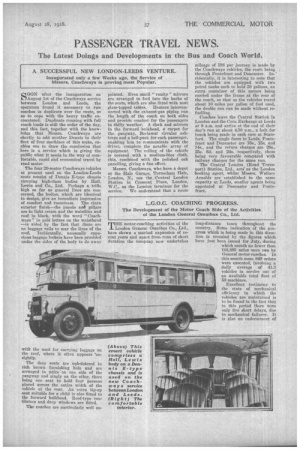PASSENGER TRAVEL NEWS.
Page 23

If you've noticed an error in this article please click here to report it so we can fix it.
The Latest Doings and Developments in the Bus and Coach World.
A SUCCESSFUL NEW LONDON-LEEDS VENTURE.
Inaugurated only a few Weeks ago, the Service of Messrs. Coachways is proving most Popular.
000N after the inauguration on V./August let of the Coachways service between London and Leeds, the operators found it necessary to run coaches in duplicate over the route, so as to cope with the heavy traffic encountered. Duplicate running with full coach loads is still the order of the day, and this fact, together with the knowledge that Messrs. Coachways are shortly to add another Dennis to their fleet of four machines of this make, enables one to draw the conclusion that here is a service which is giving the public what it needs in the way of comfortable, rapid and economical travel by road motor.
The four 20-seater Coachways vehicles at present used on the London-Leeds route consist of Dennis E-type chassis carrying high-class bodies by Hall, Lewis and Co., Ltd. Perhaps a trifle high so far as general lines are concerned, the bodies, which are identical in design, give an immediate impression of comfort and roominess. The clean exterior finish—the panels awlpillars are in light cream and the waistline and roof in black, with the word " Coachways" in gold letters on the waistband —is aided by the fact that there are no luggage rails to mar the lines of the roof. Incidentally, unusually capacious luggage lockers have been provided under the sides of the body to do away with the need for carrying luggage on the roof, where it often appears -unsightly.
The deep seats are upholstered in rich brown furnishing hide and are arranged in pairs on one side of the gangway and singly on the other, there being one seat to hold four persons placed across the entire width of the vehicle at the rear. An extra tip-up seat suitable for a child is also fitted to the forward bulkhead. Roof-type ventilators and drop windows are fitted.
The coaches are particularly well an
pointed. Even small " vanity " mirrors are arranged to fold into the backs of the scats, which are also fitted with neat glass-topped tables. Heaters interconnected with the exhaust-gas piping run the length of the coach on both sides and provide comfort for the passengers in chilly weather. A clock and mirrors in the forward bulkhead, a carpet for the gangway, Bectawat circular ashtrays and a hell-push for each passenger, enabling him to communicate with the driver, complete the notable array of equipment. • The ceiling of the vehicle is covered with a medium-blue cloth, this, combined with the polished oak panelling, giving a fine effect.
Messrs. Coachways, who have a depot at the Hale Garage, Tottenham Hale, London, N., use the Central London Station in Crescent Place, London, W.C., as the London terminus for the service. We understand that a route
mileage of 198 per journey is made by the Coachways vehicles, the route being through Pontefract and Doncaster. In-' cidentally, it is interesting to note that the vehicles are equipped with two petrol tanks each to hold 30 gallons, an extra container of this nature being carried under the frame at the rear of the coach, so that as the vehicles travel about 10 miles per gallon of fuel used, the double run can be made without re
fuelling. • Coaches leave the Central Statioli in London and the Corn Exchange at Leeds at 9 a.m. and arrive at the end of their day's run at about 4.30 p.m., a halt for lunch being made in each case at Stamford. The single fares to Leeds, Pontefract and Doncaster are 16s., 15s. and 14s., and the return charges are 26s., 25s. 6d. and 24s. respectively, these being very favourable compared with railway charges for the same rum
The Central London (Road Transport) Station, Ltd., acts-as the London hooking agent, whilst Messrs. Wallace Aruolds are established in the same capacity at Leeds, smaller agents being appointed at Doncaster and Pontefract.
































